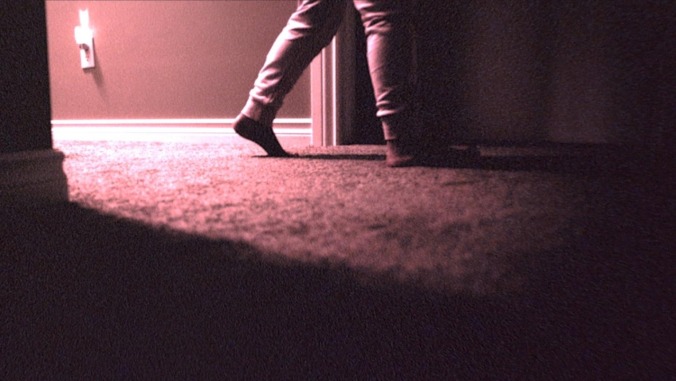Skinamarink review: low-budget film delivers big-time horror
It's still early, but Kyle Edward Ball's single-location thriller might turn out to be 2023's most frightening film

Skinamarink emerges on the 2023 horror scene having already cast a strange spell on a sizable portion of horror fandom. After making the rounds at festivals late last year, Kyle Edward Ball’s low-budget, single-location film surfaced on TikTok and elsewhere and became a viral indie sensation as users (legally or otherwise) dug into its grainy imagery, vivid use of sound, and terrifying premise. By the time 2022 rolled over into 2023, even before general audiences had the chance to see the film, it was clear that Skinamarink might be worthy of inclusion on the list of Scariest Movies Ever Made.
“Scariest” is, of course, in the eyes and ears of the moviegoer, but whether it wraps you in layers of sheer, visceral terror or simply engages a more fleeting, conceptual, horror-inclined area of your brain, it’s hard to deny that Ball’s film is scary. Beyond that, though, Skinamarink presents something experimental and often stunningly mesmeric, an unconventional take on a very conventional, near-universal fear. From shot to shot and on a grander, more existential scale, it’s a singularly nightmarish piece of horror filmmaking and one of the year’s must-see genre films.
The setup for this wonderfully strange journey plays like a version of a nightmare almost all of us had as children, whether we remember it or not. In a house that might exist in the 1980s, or might exist outside of time altogether, siblings Kaylee (Dali Rose Tetreault) and Kevin (Lucas Paul) wake up and discover their parents are gone and the house itself is behaving strangely. As they search each room for the presence of an adult, the children discover that all the external windows and doors of the house are disappearing one by one, replaced by solid walls adorned with useless blinds and fixtures.
With this strange paradigm shift firmly in place, accompanied by various other creepy phenomena, like toys that seem to stick to the ceiling, the film devotes much of its runtime to Kaylee and Kevin’s attempt to adjust to their isolated existence. Because they’re so young and so devoted to basic needs like bowls of cereal, cartoons, and toys, the siblings never descend into absolute panic. Instead, Skinamarink follows their dreamy blend of curiosity and fear wherever it leads, as the house gets darker and the mystery of what exactly is happening gets all the more compelling.
Any filmmaker telling this story would likely get at least some horror mileage out of its premise. But Ball is not interested in a direct and logical exploration of events. He takes the nightmare scenario of his screenplay and, with the help of cinematographer Jamie McRae, pushes things into the realm of childlike, disorienting wonder. The camera does not give us a straightforward version of events as Kaylee and Kevin scrounge for food and look for solutions to their various problems. It lingers in doorways and down halls and looks up at strange shadows thrown across ceilings. It hovers on the far side of a vast expanse of carpet while a television plays appropriately creepy cartoons and it drifts idly across fields of LEGO blocks and doll parts. It all gives the viewer the sense of being lost in something impenetrable, something forbidden, a nightmare that won’t end not just because we can’t find the end, but because there simply isn’t one.
Which isn’t to say there’s no sense of rising and falling tension throughout the film. Within this framework of palpable, oddly nostalgic dread, Ball builds his story patiently and in small but well-defined pieces. The film’s sound design is, like the visual style, often deliberately disorienting. The children speak almost entirely in whispers accompanied by subtitles. But it’s clear that they are seeking both survival and understanding within the confines of this strange and haunting home, and with those goals in place Ball starts to play with the scenario. Other parts of the house begin to behave in odd ways, manipulating the children as they lose all sense of the passage of time. And, most frighteningly, in some of the most harrowing sequences committed to film in recent memory, Ball makes it horrifyingly clear that the children are not necessarily alone. To say more would ruin the visceral power of it all, but when Skinamarink dials up the horror, it really dials it up, to the point where you might find yourself hiding behind your hands even while watching in broad daylight.
For some horror fans, this will not be enough. Skinamarink is, at its heart, firmly and gleefully experimental, and that means leaving more traditional forms of narrative arc building behind in favor of a darker, more mercurial approach. But if you’re willing to follow Ball and company down these dark corridors, into this twisted view of primal childhood fear and how easily we get lost in that fear, you’re in for an absolutely unforgettable horror experience. We have a long way to go in 2023, but Skinamarink is already a top contender for the year’s most frightening film.
(Skinamarink opens nationwide January 13)